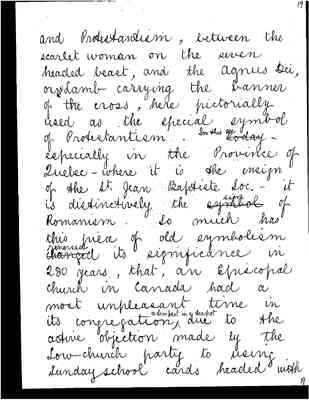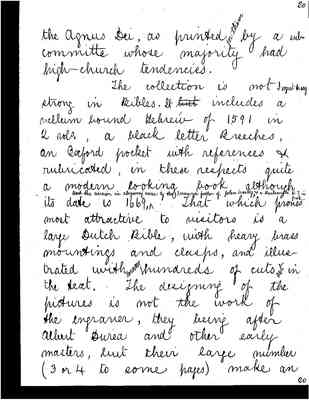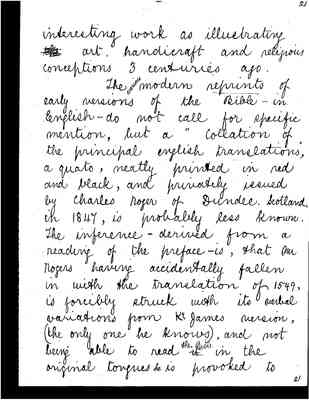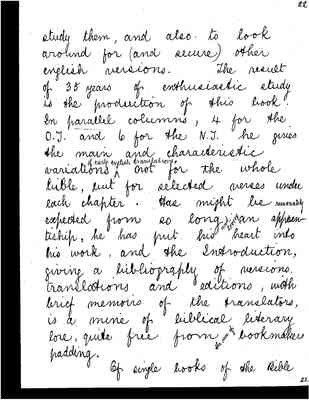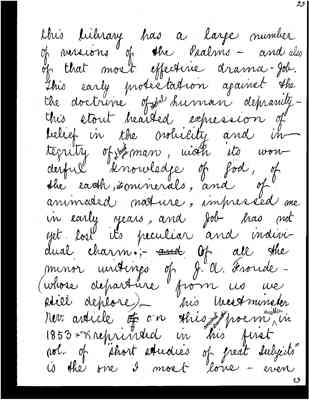Pages
19
and Protestantism, between the scarlet woman on the seven headed beast, and the Agnus Dei, or the Lamb carrying the banner of the cross, here pictorially used as the special symbol of Protestantism. In this age - especially in the Province of Quebec - where it is the ensign of the St. Jean Baptiste Soc. - it is distinctively the sign of Romanism. So much has this piece of old symbolism reversed its significance in 280 years, that, an Episcopal Church in Canada had a most unpleasant time in its congregation a tempest in a teapot due to the active objection made by the Low church party to using Sunday school cards headed with
19
20
the Agnus Dei, as printed for them by a subcommitte whose majority had high-church tendencies.
The collection is not I regret to say strong in Bibles. It includes a vellum bound Hebrew of 1591 in 2 vols., a black letter Breeches, an Oxford pocket with references & rubricated, in these respects quite a modern looking book although its date is 1669, the version is rhyming verse by the reverend father of John Wesley, & a Baskerville N.J. in Greek. That which proves most attractive to visitors is a large Dutch Bible, with heavy brass mountings and clasps, and illustrated with many hundres of cuts set in the text. The designing of the pictures is not the work of the engraver, they being after Albert Durea and other early masters, but their large number (3 or 4 to some pages) makes an
20
21
interesting work as illustrating art, handicraft and religious conceptions 3 centuries ago.
The various modern reprints of early versions of the Bible - in English - do not call for specific mention, but a "collation of the principal english translations, a quato, neatly printed in red and black, and privately issued by Charles Roger of Dundee. Scotland. in 1847, is probably less known. The inference - derived from a reading of the preface - is, that Mr Rogers having accidentally fallen in with the translation of 1549, is forcibly struck with its verbal variations from Kg. James version, (the only one he knows), and not being able to read the Bible in the original tongues he is provoked to
21
22
study them, and also to look around for (and secure) other english versions. The result of 35 years of enthusiastic study in the production of this book. In parallel columns, 4 for the O. T. and 6 for the N. T. he gives the main and characteristic variations of early english translations, not for the whole bible, but for selected verses under each chapter. Has might be reasonably expected from so long and loving an apprentiship, he has put his heart into his work, and the Introduction giving a bibliography of versions, translations and editions, with brief memoirs of the translators, is a mine of biblical literary lore, quite free from the price of bookmakers padding.
Of single books of the Bible
22
23
this library has a large number of versions of the Psalms - and also of that most effective drama - Job. This early protestation against the the doctrine of total human depravity - this stout hearted expression of belief in the nobility and integrity of at least one man, with its wonderful knowledge of God, of the earth, its minerals, and of animated nature, impressed me in early years, and Job has not yet lost its peculiar and individual charm.; - Of all the minor writings of J. A. Froude - (whose department from us we still deplore) - his Westminster rev. article on this ancient dramatic poem written in 1853 & reprinted in his first vol. of "short studies of great subjects" is the one I most love - even
23
